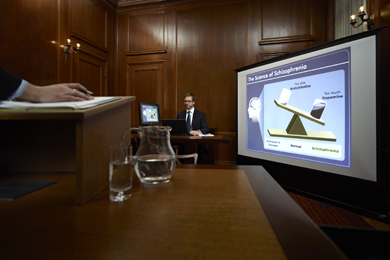Mesmerize the Jury: Crucial Elements of a Powerful Test Discussion
Necessary elements such as understanding the target market, crafting an engaging story, and grasping spoken and non-verbal interaction are vital elements of an effective discussion. As these variables intertwine, they create a cohesive method that not just informs however additionally involves jurors on multiple levels.

Recognizing Your Audience
Understanding your audience is a critical element of reliable test discussion. A successful presentation rests on the capability to realize the demographics, values, and proneness of jurors. This comprehension notifies just how disagreements are framed, evidence is provided, and emotional charms are crafted, guaranteeing that the message reverberates with the jurors on a personal level.
Research indicates that jurors come from diverse backgrounds and might have differing degrees of understanding concerning lawful procedures. Additionally, recognizing the jurors' prospective biases and life experiences allows the test presenter to expect objections and address concerns proactively.
Effective test presentation likewise entails observing jurors' reactions throughout the proceedings. Engaging with jurors as people rather than a cumulative unit is important in cultivating a strong link in the court room.

Crafting an Engaging Narrative
Crafting a compelling narrative is essential in assisting jurors via the intricacies of an instance. A well-structured narrative not only simplifies elaborate legal principles however likewise engages jurors on a psychological level, making the details extra relatable and memorable.
This message should reverberate with the jurors' values and experiences, fostering a connection that transcends plain truths. This chronological approach can help jurors adhere to the development of occasions, highlighting reason and impact.
Incorporating human elements-- such as personal stories or anecdotes-- can better improve the narrative's impact. These elements evoke empathy, allowing jurors to imagine the repercussions of the instance on realities. In addition, using a regular theme throughout the presentation enhances the primary disagreement, making it less complicated for jurors to keep crucial points.
Ultimately, an engaging story changes a trial discussion from a plain address of truths right into an influential story that mesmerizes the court, encouraging them to ponder with both factor and feeling.
Using Aesthetic Help
Integrating visual aids right into a test presentation can substantially improve jurors' understanding and retention of info. Visual materials such as charts, representations, photographs, and videos can change complex legal concepts and evidence right into quickly absorbable layouts. By engaging multiple senses, these aids permit jurors to envision the case's essential components, making it much easier for them to comply with along and grasp detailed details.
Moreover, well-designed visual help can highlight crucial points and highlight connections in websites between different items of proof. Timelines can efficiently show the sequence of occasions, while annotated images can clarify particular information pertinent to the instance. This not only aids in understanding however additionally strengthens the narrative presented by the attorney.
Extremely intricate or chaotic visuals may bewilder jurors and detract from the message. Inevitably, reliable visual communication can be a powerful device in persuading jurors and helping them reach notified conclusions.
Understanding Verbal Communication
Reliable spoken interaction is critical in a test discussion, as it offers as the main ways whereby attorneys share their debates and get in touch with jurors. Mastering this ability involves clarity, persuasion, and interaction. Attorneys need to express their factors plainly and briefly, staying clear of legal jargon that might perplex jurors. Simpleness in language cultivates understanding and aids jurors comprehend complicated issues presented throughout the trial.
Moreover, tone and pacing click this site dramatically influence how messages are gotten. A certain tone conveys authority, while proper pacing enables jurors to soak up information without feeling bewildered. Lawyers need to also vary their singing inflections to highlight vital points and maintain jurors' rate of interest throughout the discussion.
In addition, the company of verbal arguments is important. Structuring the narrative realistically and coherently aids jurors follow the lawyer's line of reasoning, making it much easier for them to keep critical information. Making use of persuasive techniques, such as storytelling, can additionally boost the emotional vibration of the disagreements offered, therefore developing a more profound connection with jurors.
Ultimately, understanding verbal interaction not just enhances a lawyer's situation but also promotes count on and relationship with the jury, considerably boosting the possibilities of a favorable judgment.

Involving With Body Movement
Nonverbal interaction plays an essential duty in test presentations, usually sharing messages that words alone can not reveal. Body language, including gestures, position, faces, and eye contact, considerably influences exactly how jurors perceive the reputation and genuineness of the speaker. A certain stance, with shoulders back and an open posture, can instill depend on, while closed-off body language might suggest defensiveness or unpredictability.

Faces need to show the feelings related to the instance, strengthening the narrative existing. As an example, a sincere expression throughout a touching moment can evoke compassion and strengthen the sob story. Eventually, grasping body language is vital for effective test presentations, as it improves verbal interaction and establishes an engaging existence that reverberates with the jury.
Verdict
In final thought, captivating the court requires a tactical strategy that includes recognizing the audience, crafting a compelling narrative, utilizing aesthetic help, grasping verbal communication, and engaging through body movement. Each aspect plays a critical function in creating an effective trial discussion that reverberates with jurors on both emotional and intellectual degrees (trial presentation). By incorporating these elements effectively, lawful professionals can dramatically improve their capacity to encourage and affect court decision-making